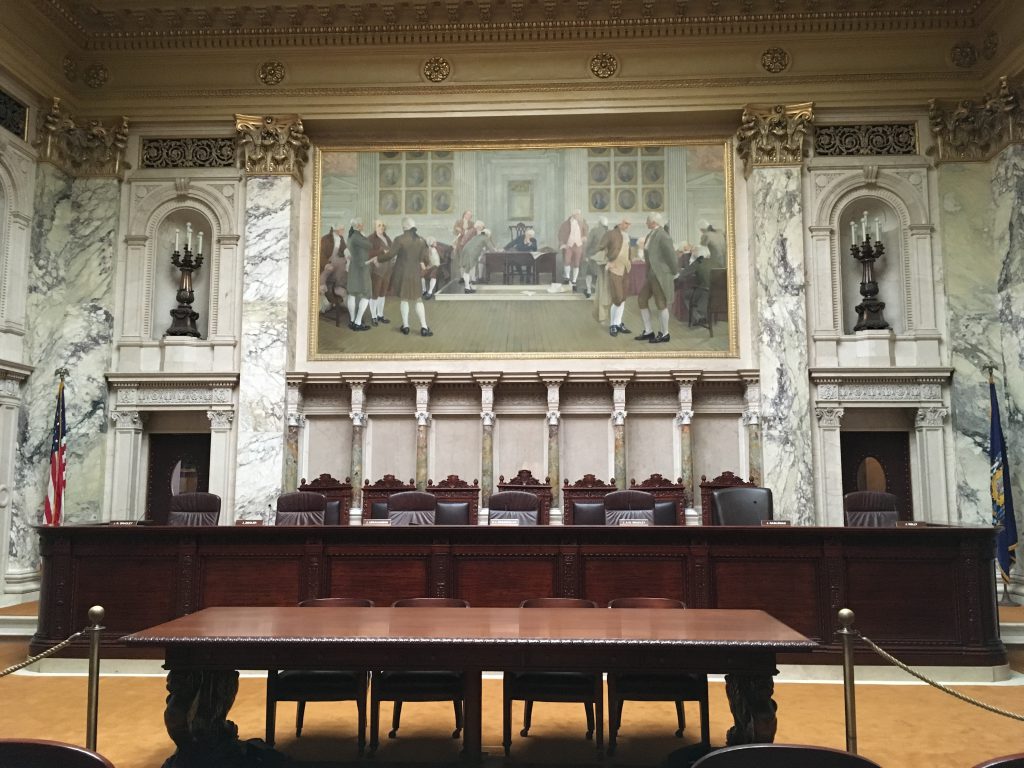What Can We Learn From Gerrymandering Case Briefs?
Seven parties submit written briefs in advance of oral arguments in Supreme Court case.
On Aug. 2, a group of Wisconsin voters submitted a petition to the Wisconsin Supreme Court asking the court to commence an “original action” challenging the state’s map of legislative seats to favor Republican over Democratic candidates. “Original action” means that the case goes directly to the Supreme Court, rather than starting with a district court.
The petitioners asked that the justices consider five issues. Here are the first three:
- Whether the state legislative redistricting plans … are extreme partisan gerrymanders that violate Article I, Section 1 of the Wisconsin Constitution’s guarantee of equal protection under law; and whether this cause of action is justiciable in Wisconsin courts.
- Whether the … plans … retaliate against voters based on their viewpoint and exercise of free speech and abridge the ability of voters with disfavored political views to associate with others to advance their political beliefs in violation of Article I, Sections 3 and 4 of the Wisconsin Constitution; and whether these causes of action are justiciable.
- Whether the plans … fail to “adhere to justice, moderation, temperance, frugality, and virtue, … fundamental principles” in violation of Article I, Section 22 of the Wisconsin Constitution; and whether this cause of action is justiciable.
On October 6, the court responded:
… we decline to grant leave to commence an original action with respect to Issues 1-3 presented in the petition. Although these issues raise important and unresolved questions of statewide significance, the need for extensive fact-finding (if not a fullscale trial) counsels against addressing them at this time.
However, the court accepted the final two issues proposed by the petitioners. These became the court’s two issues:
- Whether … plans … violate the requirement of Article IV, Sections 4 and 5 of the Wisconsin Constitution that legislators be elected from districts consisting of “contiguous territory.”
- Whether the … plans … violate the separation-of-powers principle inherent in the Constitution’s division of legislative, executive, and judicial power by usurping the Governor’s core constitutional power to veto legislation and the Legislature’s core constitutional power to override such a veto.
It added two additional issues:
- If the court rules that Wisconsin’s existing state legislative maps violate the Wisconsin Constitution for either or both of these reasons and the legislature and the governor then fail to adopt state legislative maps that comply with the Wisconsin Constitution, what standards should guide the court in imposing a remedy for the constitutional violation(s)?
- What fact-finding, if any, will be required if the court determines there is a constitutional violation based on the contiguity clauses and/or the separation-of-powers doctrine and the court is required to craft a remedy for the violation? If fact-finding will be required, what process should be used to resolve questions of fact?
Since then, there have been two cycles of briefs supporting or opposing the existing maps. A third brief is due Nov. 7 and oral argument is scheduled for Nov. 21. Six groups have contributed briefs in the first two rounds, two in favor of the current maps and four opposed. A seventh brief, from the Wisconsin Elections Commission, expressed its concern that any new maps be in place by March 15, 2024, to not interfere with the coming election, but took no position on the district maps.
In favor of the maps is a group of people who had advocated for the current plan before it was adopted. The group is represented by the Wisconsin Institute for Law & Liberty. The second brief supporting the current maps came from the Wisconsin Legislature and Republican state senators.
Among the Wisconsin Constitution’s requirements for state assembly and senate districts is that they be “contiguous.” The common definition of contiguous is that all parts of a district touch another part of the same district. Yet the present maps show a large number of “islands,” parts of districts that are completely surrounded by other districts.
This rather odd effect would seem to result from the practice of some cities to annex remote pieces of land so that developers can enjoy city services or other benefits. Apparently, there is no contiguity requirement on Wisconsin’s cities and villages. At some point, it became a practice among those drawing the maps to create the district islands so they could be in the same district as the cities they belong to. But this seems to be a clear violation of the Constitution’s mandate that the districts be contiguous.
Defenders of the current maps make a number of fairly unconvincing arguments that these islands meet the Constitution. One is that there is “literal contiguity” and “municipal contiguity,” or being close is enough. I think they will fail on this argument.
On the court’s third issue, what should be done if it concludes that the plan violates the Constitution, the answers differ widely depending on whether the briefs support or oppose the current maps. Not surprisingly, the two briefs defending the existing maps argue that only minor tweaks would be called for, such as absorbing island districts into their surrounding districts and moving district lines to bring back district populations to the average.
Opponents of the existing maps take the opposite tack, pointing to districts that would require a multitude of changes to get them back to balance. They argue that it is better to start from scratch and develop a remedial map that “neither favors nor disfavors certain voters based on their political viewpoints.”
Unspoken in all this is what drives the defenders of the existing district plan—the need to preserve the present advantage Republicans enjoy in state senate and assembly elections.
If you think stories like this are important, become a member of Urban Milwaukee and help support real, independent journalism. Plus you get some cool added benefits.
More about the Gerrymandering of Legislative Districts
- Without Gerrymander, Democrats Flip 14 Legislative Seats - Jack Kelly, Hallie Claflin and Matthew DeFour - Nov 8th, 2024
- Op Ed: Democrats Optimistic About New Voting Maps - Ruth Conniff - Feb 27th, 2024
- The State of Politics: Parties Seek New Candidates in New Districts - Steven Walters - Feb 26th, 2024
- Rep. Myers Issues Statement Regarding Fair Legislative Maps - State Rep. LaKeshia Myers - Feb 19th, 2024
- Statement on Legislative Maps Being Signed into Law - Wisconsin Assembly Speaker Robin Vos - Feb 19th, 2024
- Pocan Reacts to Newly Signed Wisconsin Legislative Maps - U.S. Rep. Mark Pocan - Feb 19th, 2024
- Evers Signs Legislative Maps Into Law, Ending Court Fight - Rich Kremer - Feb 19th, 2024
- Senator Hesselbein Statement: After More than a Decade of Political Gerrymanders, Fair Maps are Signed into Law in Wisconsin - State Senate Democratic Leader Dianne Hesselbein - Feb 19th, 2024
- Wisconsin Democrats on Enactment of New Legislative Maps - Democratic Party of Wisconsin - Feb 19th, 2024
- Governor Evers Signs New Legislative Maps to Replace Unconstitutional GOP Maps - A Better Wisconsin Together - Feb 19th, 2024
Read more about Gerrymandering of Legislative Districts here
Data Wonk
-
Why Absentee Ballot Drop Boxes Are Now Legal
 Jul 17th, 2024 by Bruce Thompson
Jul 17th, 2024 by Bruce Thompson
-
The Imperial Legislature Is Shot Down
 Jul 10th, 2024 by Bruce Thompson
Jul 10th, 2024 by Bruce Thompson
-
Counting the Lies By Trump
 Jul 3rd, 2024 by Bruce Thompson
Jul 3rd, 2024 by Bruce Thompson





















thanks for this analysis
i’m hopeful that as a result, 48% of my neighbors won’t be represented by 66% of my legislature